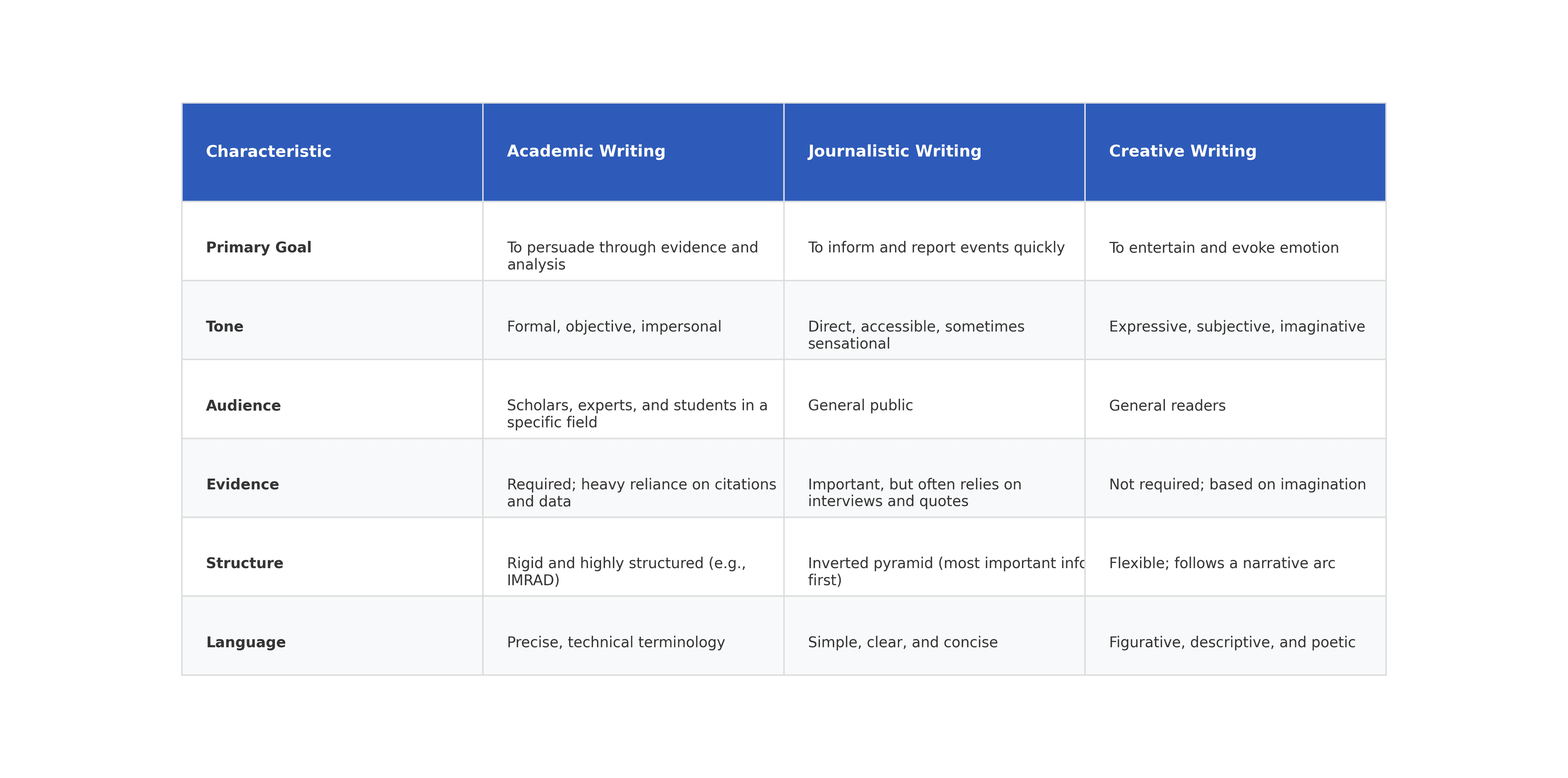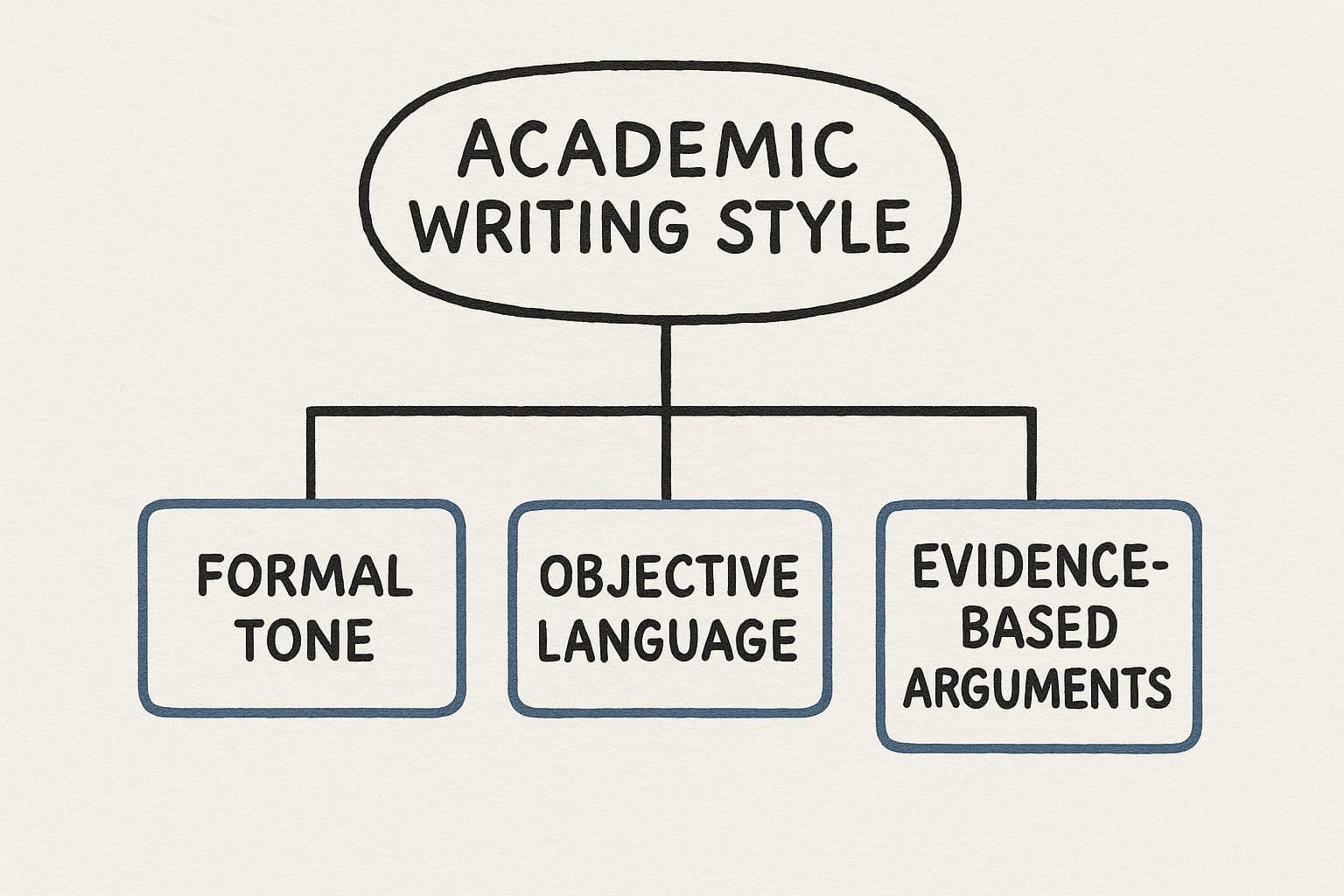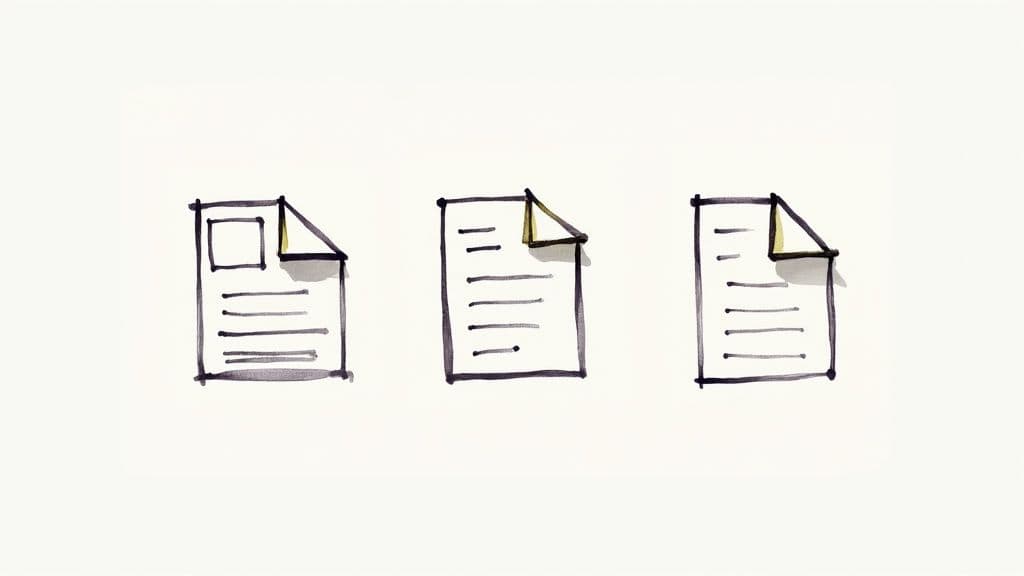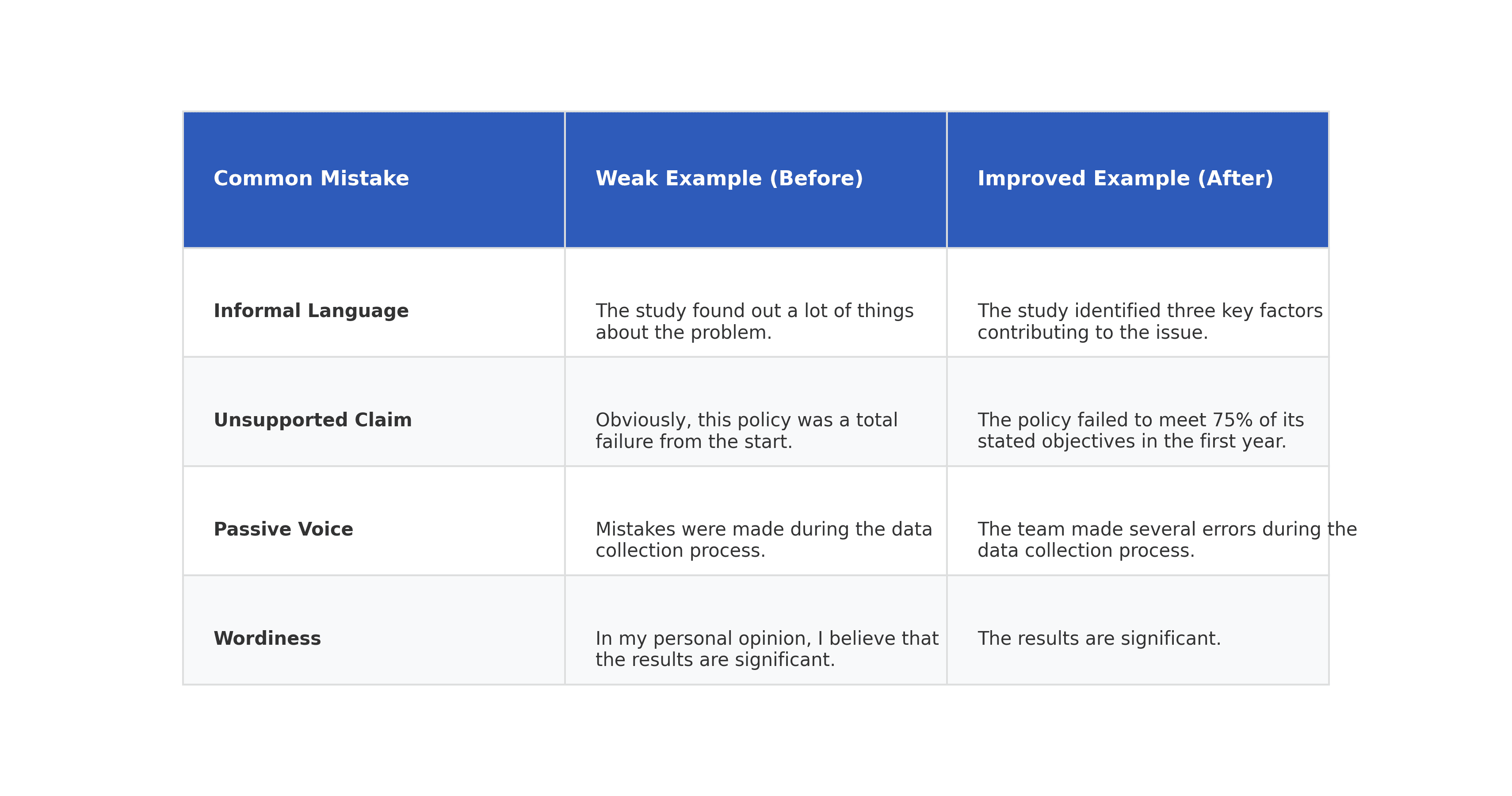Tutorial
What Is Academic Writing Style? A Clear Guide
If you've ever tried to switch from writing a casual email to a formal essay, you know the whiplash. The styles feel like they're from different planets. Academic writing style is its own unique beast—a formal, evidence-based way of communicating that’s all about clarity, objectivity, and building trust with your reader.
It's not about stuffing your sentences with fifty-dollar words to sound smart. Far from it. Think of it as the official language of your field, designed to present a structured, logical argument backed up by cold, hard facts.
Getting a Real Feel for Academic Writing
Let's ditch the dry, textbook definitions for a second. The best way to understand academic writing is to see it as joining a very serious, very important conversation that's been going on for years.

Imagine a lawyer making their final argument to a jury. Every claim is deliberate. Every piece of evidence is presented methodically. There's no room for fluff or unsupported opinions. That's the core of academic writing—it's a toolkit for explaining complex ideas with surgical precision and earning your reader's confidence.
This style lives and dies by its evidence. Your personal insights are valuable, but they only become powerful when you anchor them in credible research. In fact, it’s common for about 70–80% of the content in an academic paper to be directly supported by or referenced from other sources. You can dig deeper into these kinds of academic writing standards to see just how central evidence is.
How It Stacks Up Against Other Writing Styles
Sometimes, the easiest way to understand what something is is to look at what it isn't. Unlike a blog post that wants to grab your attention or a news story that aims for an emotional punch, academic writing puts objectivity and deep analysis first. The goal isn't just to tell you something; it's to persuade you with a meticulously constructed, data-driven argument.
> "The core of academic writing is to present a clear, logical, and evidence-based argument. It’s a structured dialogue with other scholars in your field, where your contribution is carefully positioned within an existing body of knowledge."
Let's take one topic—a local community's water quality crisis—and see how different writers would tackle it:
* A journalist would likely tell a human-interest story, focusing on interviews with affected families and the immediate public health impact.
* A creative writer might write a poem or a short story, using imagery and emotion to convey the feeling of living without clean water.
* An academic writer would take a different route entirely. They'd analyze the chemical causes of the contamination, present hard data on pollution levels, and review previous scientific studies on potential filtration solutions.
This methodical, almost impersonal approach isn't designed to be dull. It's a system that keeps the focus squarely on the ideas and the evidence, creating a level playing field where scholars anywhere can engage with the argument on its own terms.
To make these differences crystal clear, here’s a quick side-by-side comparison.
Academic Writing vs Other Writing Styles

This table really highlights how academic writing is built for a specific purpose: to contribute a verifiable, credible piece to the ongoing puzzle of human knowledge.
Mastering the Four Pillars of Academic Writing
If you really want to get what academic writing is all about, it helps to break it down. Think of it like a building—it needs solid pillars to keep it standing strong. In the same way, good academic writing stands on four key pillars: Formality, Objectivity, Precision, and Structure.
Get these four elements right, and your writing will go from just a bunch of ideas to a solid, professional argument that people in your field will actually respect. Let's dig into each one so you can start putting them to work.
Maintaining a Formal Tone
Formality in academic writing isn't about swallowing a thesaurus to sound smart. It’s about adopting a professional, serious tone that fits the scholarly conversation you're joining. This means you have to drop the casual chat, slang, and contractions.
Picture yourself presenting your findings at a big conference. You'd pick your words carefully to show respect for the audience and your subject, right? It's the exact same idea here.
* No Contractions: Write out "do not" instead of "don't," and "it is" instead of "it's." Simple, but it makes a huge difference.
* Ditch the Slang: Words like "a lot," "thing," or "basically" are too vague. Swap them for more specific terms like "a significant amount," "a key factor," or "fundamentally."
* Limit Rhetorical Questions: They can feel a bit too conversational for this style of writing. It's better to just state your points directly.
This infographic breaks down how a formal tone, objective language, and evidence-based arguments are the core traits of academic writing.

As you can see, these aren't just separate rules; they all work together to define the style. Nailing this tone builds your credibility and shows you’re a serious voice in the academic world.
Embracing Objectivity
Objectivity is the absolute bedrock of academic credibility. You have to present information and arguments in a neutral, unbiased way and let the evidence do the talking. That means your personal feelings, opinions, and beliefs need to stay out of it.
Your job is to step back from the story and put the focus squarely on the data and research. The strength of your argument comes from the proof you offer, not how passionately you feel about it.
> An objective stance lets the reader judge your argument on its own merits. When you strip out personal bias, you’re inviting them to trust your analysis and follow your logic without getting skeptical.
For example, instead of writing, "I believe the study's results are incredibly disappointing," you’d take an objective route: "The study's results indicate a 35% decline in efficacy, which is inconsistent with previous findings." See how that shifts the focus from your emotional take to a hard fact?
The Importance of Precision
Vague statements are the enemy of a strong academic argument. Precision is all about using language that is specific, clear, and can't be misinterpreted, especially when you're talking about data, concepts, or methods. Every word should have a definite meaning, and every number needs to be exact.
Generalizations like "many people" or "a big increase" just won't cut it. Academic writing needs the specifics.
* Instead of: "The new policy had a positive effect."
* Try: "The new policy led to a 15% reduction in response times within the first quarter."
This kind of detail does more than just make you sound credible. It allows other researchers to understand, critique, and even try to replicate your work—which is how scholarly fields move forward. Precision makes sure your contribution to the conversation is both clear and valuable.
Building Your Argument with Evidence
The real muscle behind any piece of academic writing isn't just clever phrasing or your personal take on a subject—it's the strength of the evidence you present.
Think of it like you're a lawyer building a case in court. Your central argument is the claim you're making, but without solid evidence—witness testimony, expert reports, physical proof—the jury won't be convinced. Your sources are your expert witnesses. Without them, even the most passionate argument falls apart under questioning.

This is why getting a handle on what is academic writing style really means learning how to weave evidence into your work. Every point you make needs backup to show your reader that your ideas are built on a solid foundation of existing knowledge. It’s not about just dropping in random facts; it's about skillfully integrating research into your own narrative to build a case that's impossible to ignore.
Quoting, Paraphrasing, and Summarizing
When it comes to bringing in that evidence, you have three main tools in your kit. Knowing when to use each one is key to crafting a paper that flows well and makes a powerful point.
* Quoting: Use a direct quote when an author's original words are just too perfect to change. Maybe the phrasing is incredibly powerful, memorable, or precise. This is your scalpel—use it for surgical precision when you need to highlight a key definition or a truly impactful statement.
* Paraphrasing: This is your everyday workhorse. Paraphrasing means taking a specific idea from a source and putting it into your own words and sentence structure. It lets you keep your writing smooth and in your own voice while still properly crediting the original idea.
* Summarizing: When you need to give the gist of a much larger work—like an entire article, chapter, or study—you summarize. Think of this as giving the "big picture" overview. It’s perfect for providing context or background without getting lost in the weeds.
A strong academic paper uses a healthy mix of all three. You'll choose each one strategically based on what best serves the argument you're making at that moment.
> The goal is to make your sources work for you. Don't just list them off. They should be active players in your paper, helping you build, support, and deepen your own analysis. Your voice should always be leading the conversation, with the evidence serving as the expert testimony that has your back.
The Role of Citation
If evidence is the foundation, then proper citation is the engineering that holds the whole structure together. It's way more than just a way to avoid plagiarism—it's about being transparent and building trust with your reader.
When you cite your sources, you're essentially giving your reader a roadmap. You’re showing them exactly where your information came from and inviting them to check it out for themselves. It proves you've done your homework.
Different fields of study use different "blueprints" for this, which we call citation styles. The big three are:
Use our Free AI Detector to check your content
1. APA (American Psychological Association): The go-to style for social sciences, education, and psychology.
2. MLA (Modern Language Association): Used almost everywhere in the humanities, like literature, philosophy, and language studies.
3. Chicago/Turabian: A flexible style popular in history, business, and the arts. It even offers two different systems to choose from.
Learning the rules for each style can feel a bit tedious at first, but they all share the same purpose: to create a clear, standardized format so anyone in your field can easily follow your research trail. Following the correct style isn't just about rules; it shows you're a professional who understands the conventions of your academic community. Ultimately, good citation is what turns a paper from a list of opinions into a real, verifiable contribution to the ongoing scholarly discussion.
Common Mistakes in Academic Writing to Avoid
Even the sharpest writers can stumble into a few common traps that weaken their arguments and chip away at their credibility. Understanding academic writing is as much about knowing what to do as it is about knowing what not to do.
Think of this as your personal editing checklist. Avoiding these frequent missteps is one of the fastest ways to make your writing feel more polished, clear, and persuasive. Most of these mistakes creep in from our more casual, everyday writing habits. The good news? Once you learn to spot them, they’re surprisingly easy to fix.
Using Casual or Vague Language
This is probably the most common one. It's easy to let informal language slip into your work, but phrases that are perfectly fine in a conversation can make an academic paper sound sloppy and unprofessional.
Watch out for words like "things," "a lot," or "stuff." The same goes for contractions like "don't" or "it's." This kind of language is just too broad and lacks the sharp specificity you need for a strong argument. You end up creating ambiguity where you need absolute clarity.
The fix is simple: swap those vague terms for precise nouns and hard data. And always—always—write out the full words instead of using contractions. It’s a small change that instantly bumps up the formality.
> A core principle of academic writing is that every single word serves a purpose. Vague language introduces static, forcing the reader to guess your meaning and undermining the entire logical foundation of your work.
Making Sweeping Generalizations
Another classic mistake is making big, bold claims without the evidence to back them up. Red flags are statements like "Everyone knows that..." or "It is obvious that..." An argument is only as strong as the proof you provide.
If you’re looking to sharpen your ability to build solid, evidence-backed points, these 7 ways to improve your essays offer some practical strategies that really work.
Overusing the Passive Voice
The passive voice has its moments, but leaning on it too heavily makes your writing feel weak, indirect, and just plain clunky. It often hides who is actually doing the action, which can lead to confusing and tangled sentences.
Here's the difference:
* Passive: "The experiment was conducted by the researchers."
* Active: "The researchers conducted the experiment."
See how the active voice is more direct and energetic? It clearly points to the "doer" of the action, which strengthens your writing and makes it much easier to follow. Switching to an active voice makes your points land with more confidence.
Common Academic Writing Errors and Fixes
To really drive this home, let's look at a few common errors side-by-side. This table shows how small, targeted changes can make a massive difference in the quality and impact of your writing.

As you can see, the "after" examples are more direct, precise, and authoritative. They don't just state a point; they present it with the kind of clarity and evidence that academic readers expect. Getting these details right is what separates good writing from great writing.
How Technology Is Shaping Academic Writing
Let's be clear: academic writing isn't some stuffy, unchanging tradition stuck in an ivory tower. It’s a living thing, and it’s evolving right alongside the tools we use to research, write, and hash out ideas. While the core principles—crafting a clear, evidence-based argument—are as solid as ever, the way we get there is undergoing a massive shift. Digital tools have graduated from simple word processors to become genuine partners in the scholarly process.

This isn't just a minor tweak; it's fundamentally changing how we communicate complex ideas. The conversation is no longer confined to static text on a page. It's becoming more dynamic and interactive. These tools don't do the critical thinking for you, but they can definitely give it a serious boost.
The Rise of AI and Digital Tools
AI writing assistants have quickly become powerful allies in the academic workflow. They can help with everything from tightening up a clunky sentence to ensuring your grammar is consistent across a 50-page paper. Think of them less as an author and more as a tireless editor who’s always on call, ready with suggestions to improve clarity and precision. If you're curious, you can check out our guide on [using AI as your writing coach](https://www.stealthgpt.ai/blog/using-ai-as-your-writing-coach) to see how you can fold them into your own process.
But it's not just about generating text. Other technologies are making a huge splash, too:
* Data Visualization Tools: Software like Tableau (or even the souped-up functions in Excel) lets researchers transform sprawling datasets into clean, powerful charts and infographics. Suddenly, complex findings become much easier for anyone to grasp.
* Reference Management Software: Anyone who has manually built a bibliography knows the pain. Tools like Zotero and Mendeley completely automate the tedious process of citation, saving countless hours and ensuring pinpoint accuracy.
* Digital Publishing Platforms: The jump to interactive journals and online appendices means you can now embed videos, audio clips, and even interactive models right inside your work.
This isn’t just a passing fad. The numbers tell a pretty clear story. Analysis predicts that by 2030, academic work will lean more heavily on visual and audio elements like infographics and video abstracts. This is already mirrored in student habits, where search volume for terms like "AI essay writer" shot up by a staggering 537%, while searches for old-school writing services dropped off.
> This evolution doesn’t water down the classic academic writing style; it expands it. The goal is the same as it ever was: to communicate complex ideas clearly and persuasively. Technology is simply giving us a more diverse and powerful toolkit to get the job done.
At the end of the day, while the tools are new, the foundation is timeless. Strong critical thinking, logical argumentation, and solid evidence are still what separate great academic work from the rest. Technology is here to support those pillars, not to knock them down.
Frequently Asked Questions About Academic Style
Getting the hang of academic writing throws up a lot of questions. Don't worry, that's completely normal. Mastering this style is a journey, and it's smart to ask about the specific rules and quirks along the way.
Think of this section as your cheat sheet. We're tackling the most common hurdles writers face, giving you straightforward advice to help you write with more confidence and precision.
Can Academic Writing Ever Be Creative?
Absolutely, but not in the way you might think. We're not talking about flowery prose or making up stories. In the academic world, creativity is all about your ideas. It's about intellectual creativity.
This means finding fresh connections between existing theories, crafting a completely original argument, or even designing a groundbreaking research method. The real artistry is in your thinking and how you structure your case, not in breaking the rules of formal writing. A truly creative paper might flip a long-held belief on its head, all while sticking to the core principles of formality, objectivity, and solid evidence.
Is It Okay to Use "I" in Academic Writing?
Ah, the classic question. The answer here has definitely changed over time. For years, using the first person ("I" or "we") was a huge no-no because it was thought to make the writing less objective. The goal was to keep the spotlight on the research, not the researcher.
But times have changed. Many fields now accept, and sometimes even encourage, using "I" in specific contexts. For example, you might use it to make your own position crystal clear or to walk the reader through the exact steps you took in your study. It removes ambiguity.
> Guideline: When in doubt, always check the style guide for your specific field (like APA or MLA) or just ask your professor. A good rule of thumb is to use "I" sparingly. It works best when stating your thesis ("In this paper, I argue that...") or explaining your method ("First, I conducted three interviews...").
How Formal Does My Writing Need to Be?
Formality is a big deal in what is academic writing style, but that doesn't mean your writing should be clunky or impossible to read. You're aiming for professionalism, not complexity just for the sake of it. Picture it like dressing for a serious job interview—you want to look sharp and be taken seriously.
This boils down to a few key habits:
* No contractions. Write out "do not" instead of "don't."
* Ditch the slang. Avoid casual phrases like "a lot" or "basically."
* Use precise language. Use the correct terminology for your subject.
The balancing act is to be professional enough to sound authoritative without making your writing so dense that your reader gets lost. Clarity and professionalism are the goals.
---
At StealthGPT, we get the pressures of academic writing. Our tools are built to help you produce polished, human-sounding content, sharpen your arguments, and make sure your work meets the high standards of your instructors. Whether you're stuck on an essay or need to humanize text, we've got your back. https://stealthgpt.ai
